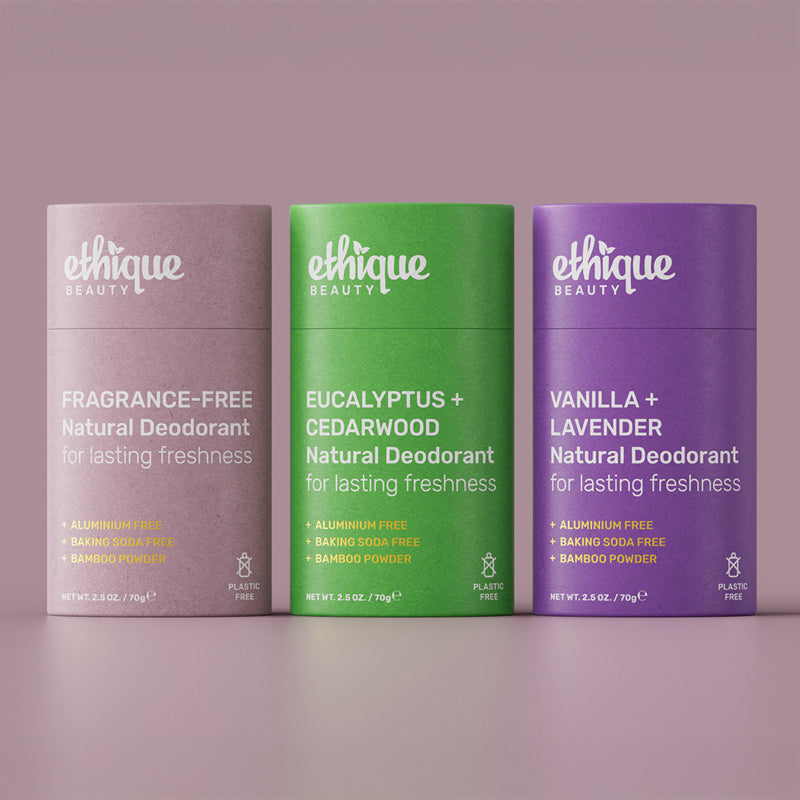Baking soda deodorants sound simple and clean. For some people, they work. For many others, they sting. If you’ve tried a stick with sodium bicarbonate and felt underarm irritation, you’re not imagining it. This guide breaks down why baking soda can be rough on the underarms, what the science says, and the bicarbonate-free options that keep you fresh without the fallout.
What baking soda does in deodorant
Sodium bicarbonate is alkaline. It neutralizes smelly acids and can slow odor-making bacteria, which is why it shows up in some natural deodorants. But skin isn’t alkaline. Healthy skin sits on the acidic side—often called the acid mantle—which supports the skin barrier and the skin microbiome. Research shows skin surface pH averages below 5 and that barrier function depends on this acidity.
A paste or stick made with baking soda pushes pH the other way. In water, it sits around pH 8–9 per chemistry data. That’s a big leap for thin, freshly shaved underarm skin. (We’ve all learned the hard way that “tingly” in the pits is not a fun surprise.)
How baking soda can affect your skin
pH imbalance and your skin barrier
Your barrier likes things mildly acidic. Raise that pH and you risk pH imbalance, enzyme disruption, and extra moisture loss. Studies link higher skin pH with impaired barrier. Even alkaline cleansers can increase transepidermal water loss (TEWL) and redness in clinical testing.
Because baking soda lives in the pH 8–9 range, frequent use can keep the underarm environment too alkaline. For some people, that means tightness, sting, and a cranky barrier that reacts to almost anything. Not the vibe you want from a daily stick.
Irritation, rash and sensitivity
Deodorants are a common source of contact dermatitis. Dermatology reviews flag underarm reactions from fragrance mixes and certain preservatives, and patch-test data keep fragrance near the top of offender lists. Add a strongly alkaline powder like sodium bicarbonate and it’s easy to see why deodorant rash, armpit rash, and underarm irritation show up—especially if you have sensitive skin.
Abrasiveness and over-exfoliation
Texture counts. Finely milled baking soda can still feel gritty on delicate underarm skin. Shave in the morning, rub on a gritty stick, then go about your day—friction does the rest. Repeated irritation can lead to post-inflammatory hyperpigmentation (PIH), especially on deeper skin tones per dermatology references and classic reviews on PIH. Translation: your skin remembers.
Real stories and what they tell us
Search any forum and you’ll find people describing “chemical burns” or rashes that show up weeks into using baking soda in deodorant. Anecdotes aren’t trials, but they track with the mechanism above: alkaline exposure + shaving + friction = a higher chance of irritation for some. Consider those reports a nudge to listen to your skin and adjust early.
Better options if baking soda bothers you
pH-balanced odor fighters
You don’t need bicarb to smell fresh. Deodorant alternatives can keep odor down without spiking pH:
- Magnesium hydroxide helps neutralize odor and is popular in gentle deodorant bars.
- Zinc compounds (e.g., zinc oxide or zinc salts) offer antimicrobial properties in certain forms and can support odor control in lab studies.
- Enzyme or plant-based systems target odor precursors before they smell.
These bicarbonate-free approaches aim to respect the skin’s environment while keeping you confident.
Watch for other common irritants
If you’re reactive, read labels closely. Essential oils and complex fragrance blends are among the most common allergens seen in patch-test clinics in modern reviews and contact-dermatitis studies. If you love scent, choose simple blends, start low, and patch test first. A little restraint up front saves a lot of side-eye from your pits later.
Why Ethique deodorant bars are different
Ethique’s bars skip baking soda entirely. The formulas are bicarbonate-free and built around magnesium hydroxide, zinc oxide, and bamboo powder in plastic-free packaging. The goal is steady freshness in a gentle deodorant that suits everyday use, without the alkali spike linked to pH imbalance. You’ll also find both scented options and a fragrance-free pick for sensitive skin. Choose what fits your routine—your underarms will vote with comfort.
How to switch without upsetting your skin
- Patch test first. Apply to a small area for 24–48 hours.
- Ease in. Alternate your old and new deo for a few days.
- Time your shave. Apply deodorant when skin feels calm, not right after shaving.
- Soothe if needed. If you see a deodorant rash, pause use, cleanse gently, moisturize, and let skin settle.
- Cut friction. Wear breathable fabrics and skip tight seams until the area is happy again.
These simple steps lower the odds of underarm irritation while you transition. Think of it as pit diplomacy.
FAQs
Is it an allergy or pH irritation?
Both happen. Fragrance and other allergens can trigger allergic contact dermatitis, while alkaline pH imbalance can cause non-allergic irritation. A dermatologist can help with patch testing using standard protocols.
Why does a rash show up weeks later?
Irritation can build slowly. Shaving, friction, and repeated alkaline exposure stack up until the skin says “enough.”
Can baking soda cause dark patches?
Ongoing irritation can lead to post-inflammatory hyperpigmentation. Calming the underarm routine and protecting the skin barrier can help per dermatology references.
Do deodorants change the underarm microbiome?
Yes. Studies show deodorants and antiperspirants can shift the skin microbiome in the armpit in controlled cohorts. Effects vary by formula.
Are bicarbonate-free formulas weaker?
Not by default. Smart deodorant alternatives—like magnesium- or zinc-based systems—can offer strong odor control without the alkaline bite.
References
- Lambers H, et al. Natural skin surface pH is on average below 5. Int J Cosmet Sci. 2006. https://pubmed.ncbi.nlm.nih.gov/18489300/
- Schmid-Wendtner MH, Korting HC. The pH of the skin surface and its impact on the barrier. Acta Derm Venereol. 2006. https://www.medicaljournals.se/acta/content/abstract/10.1080/00015555-0097
- PubChem compound summary: Sodium bicarbonate—solution pH. https://pubchem.ncbi.nlm.nih.gov/compound/Sodium-bicarbonate
- Khosrowpour Z, et al. Effects of soaps on TEWL and erythema. J Cosmet Dermatol. 2019. https://pubmed.ncbi.nlm.nih.gov/30734910/
- Zirwas MJ, et al. Antiperspirant and deodorant allergy—diagnosis and management. J Clin Aesthet Dermatol. 2008. https://www.ncbi.nlm.nih.gov/pmc/articles/PMC2921752/
- Sukakul T, et al. Fragrance contact allergy—review. Acta Derm Venereol. 2024. https://medicaljournalssweden.se/actadv/article/view/7376
- Lawrence E, et al. Post-inflammatory hyperpigmentation. StatPearls. 2022. https://www.ncbi.nlm.nih.gov/books/NBK559150/
- Taylor SC. Pathogenesis of postinflammatory hyperpigmentation. Cutis. 2003. https://pubmed.ncbi.nlm.nih.gov/14601247/
- Draelos ZD. Cosmetic Dermatology: Products and Procedures. 2015. (overview of deodorant actives)
- Sirelkhatim A, et al. Zinc oxide nanoparticles: antibacterial activity review. Molecules. 2015. https://www.ncbi.nlm.nih.gov/pmc/articles/PMC4580514/
- North American Contact Dermatitis Group. Fragrance as a contact allergen. Dermatitis. 2017. https://pubmed.ncbi.nlm.nih.gov/28301455/
- Callewaert C, et al. Deodorants/antiperspirants affect the axillary bacterial community. Arch Dermatol Res. 2014. https://pubmed.ncbi.nlm.nih.gov/25128347/

 Impact
Impact Blog
Blog Store Locator
Store Locator

